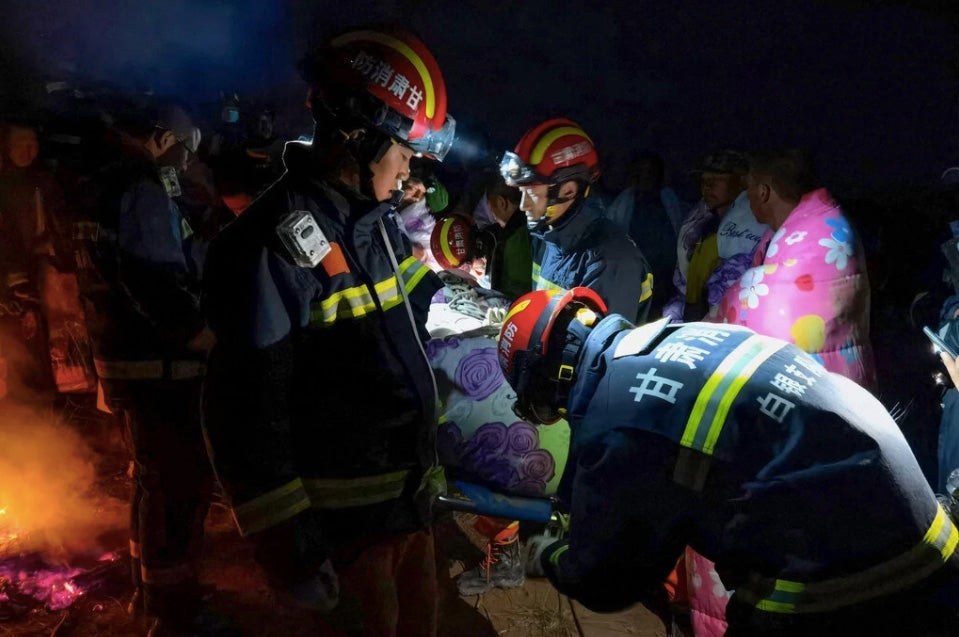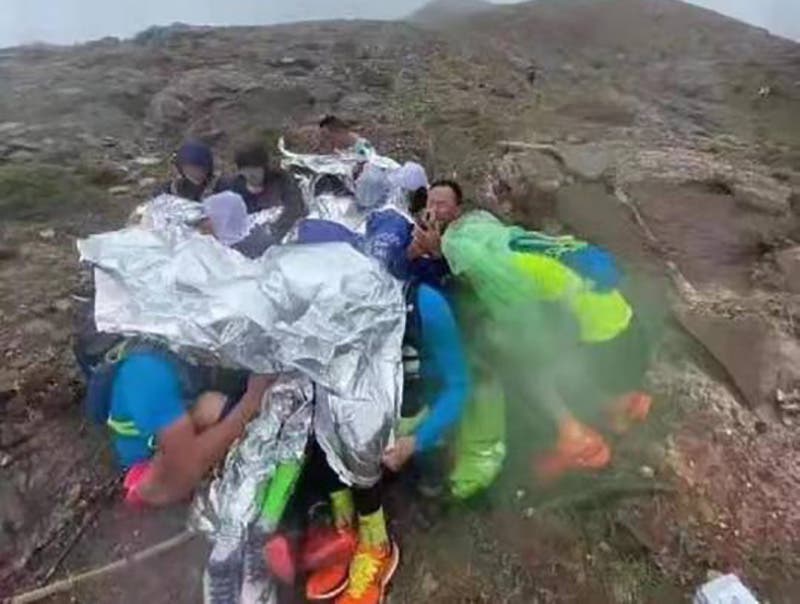Why 21 People Died in a Trail Ultramarathon

Rescuers helped runners suffering from hypothermia and various injuries in Yellow River Stone Forest 100k in the Chinese province of Gansu on Saturday after extreme weather killed 21 runners.
The news notification that came across many trail runner’s smartphones in North America late on Saturday night was downright horrifying.
“Twenty-one dead as extreme weather hits ultramarathon in China”
No matter how the story would play out behind the headline, it was clear that it was a sad and horrific tragedy of epic proportions, and it would hit home with anyone who’s ever entered a trail running race — especially an ultra-distance race in the mountains. Sadly, reading several stories about the Yellow River Stone Forest 100k the following morning proved that to be true.
The race, held at Yellow River Stone Forest Park in Gansu Province in a northwestern part of China, is organized by the Baiyin Municipal Committee, Baiyin City Sports Bureau and the local branches of the Communist Party of China. The deaths prompted outrage in China, with online commentators questioning the preparedness of the local government that organized the race, according to the New York Times.
China has become a hot spot for trail running in recent years, with more new races and participation there than anywhere else in the world. All endurance sports have been booming in China for the past decade as part of a changing cultural landscape with a new focus on leisure-time hobbies, fitness and outdoor recreation. There are hundreds of trail running races in the country and numerous ultra-distance events that have been started in the past few years, including the Gaoligong by UTMB with races from 55K to 160K.
The challenging, high-altitude Yellow River Stone Forest 100K began early on Saturday morning, with more than 170 eager runners toeing the line in cool, breezy but mostly mild conditions. There were a handful of internationally known elites and numerous fast age-groupers, but it was largely a field of novice recreational runners.
As the morning wore on, winds began to pick up, temperatures began to drop and by 1 p.m. runners were greeted with freezing rain, hail, gale-force winds and a significant drop in temperatures pelting runners, according to the People’s Daily state-run media outlet. Most runners were between the 20k and 31k section of the course, with the lead runner already heading up a steep, 3,200-foot ascent with precarious footing and sections that required hand-over-hand scrambling on rocks.
As conditions worsened, temperatures continued to drop, winds gusted harder and the rocky trails turned to slippery, iced-over surfaces. Most runners were defenseless against the weather, wearing not much more than T-shirts, shorts and trail running shoes.
Runners began to fall amid the wind and ice and succumb to the cold, with many becoming weary from what news reports have attributed to hypothermia. Several races went missing from the course as calls for help went out on cell phones and social media platforms.
The race was halted at about 2 p.m. and search-and-rescue efforts ensued. According to Chinese state-run media, more than 1,200 rescuers were called into action and army soldiers used thermal-imaging drones and radar detectors to try to locate missing runners.
Rescue efforts continued into the next day, despite complications from a mudslide. By mid-day, Sunday, 151 of the 172 race participants had been confirmed safe, with eight in hospital, but the remaining 21 had been confirmed to have been killed in the storm.
A worker at the local meteorological bureau said the bureau had issued a warning of strong winds and forecasts of showers one day before the race, according to The Beijing News. But the warning did not preclude the ultimately fatal leg of the race.
One of the 21 runners who died on the course was Jing Liang, a notable Chinese ultrarunner who had won the previous three editions of the race. Liang twice raced UTMB in Chamonix, France, finished second at the Ultra-Trail Mount Fuji in Japan in 2019 and was the runner-up at the Hong Kong 100K in 2020. Guan-Jun Huang, the winner of the men’s marathon for hearing-impaired runners at China’s 2019 National Paralympic Games, also died in the storm, according to several reports.
So what went wrong? How did so many runners die?
The Global Times published a scathing report on Monday that pointed blame at the race organization. It asked whether the disaster was a rare unfortunate incident or whether it revealed a grave situation of lack of adequate safety guarantees and assistance to runners as a common phenomenon in the country’s booming running race business.
“While it’s the hypothermia that directly caused their death, several insiders in China’s marathon business said the organizing committee should shoulder the main responsibility for failing to provide enough organizational, tactical, rescue, and security support for the event,” the report said.

- Competitors in the Yellow River Stone Forest 100k huddle together under space blankets to try to stay warm amid severe winds and sub-freezing weather on Saturday in the Gansu Province of northwestern China.
A professional rescue expert who has participated in similar races in Shandong Province told the Global Times he believed that in Gansu’s case, the root cause was the organizing committee did not want to spend money on security, so they did not employ professional rescue teams to offer enough assistance during the course.
According to iRunFar.com, the mandatory gear list didn’t include jacket or hat. However, it did include the need to carry a space blanket, cell phone, whistle, water container, headlamp, whistle, race bib, timing chip, GPX file of the course, a GPS tracker. The “recommended” list of gear for runners included a jacket, a Buff, trekking poles, electrolyte drinks, water, energy supplies, petroleum jelly and a first-aid kit.
In the days following the disaster, athletes of all levels reached out to local media and on social media platforms to voice criticism of the race administration’s lack of organization and emergency preparedness. Many runners told stories of being overcome by the wind and cold and being forced to shelter in place or retreat backward on the course.
They were husbands, wives, fathers, mothers, brothers, sisters, neighbors and co-workers, not to mention passionate runners and somebody’s running buddies.
While most of the runners killed seemed to be from the front of the race, it’s not about how fast they were as runners. It’s that they were just ordinary people competing in a race for the love of running. They were husbands, wives, fathers, mothers, brothers, sisters, neighbors and co-workers, not to mention passionate runners and somebody’s running buddies.
That so many people in the trail running community are feeling the loss speaks to how close to home it feels, even though it happened a world away in a remote section of China.
“I feel this. It could have happened to any of us!” elite American ultrarunner Camille Herron from Colorado wrote on Instagram. “Our ultra mindset is to persevere and push through anything. I’ve felt a heaviness thinking about this today. My heart goes out to all of those impacted by this tragedy.”
“So sad today. We lost 21 members of our tribe in China,” echoed Mike Wardian, an elite ultrarunner from Arlington, Va. “We will not forget them.”
The magnitude of this disaster certainly begs many questions be asked. Did race officials not anticipate the drastic change in weather that was in the forecast? Did the race not have a mandatory gear requirement that would have at least would have meant that every runner would have been carrying some additional clothing? Was there no contingency plan for safety on the mountain? While it’s perhaps still too soon to be harshly skeptical from afar, a government investigation will hopefully reveal more answers to the questions that need to be answered.
In the meantime, it’s easy to wonder if this could happen somewhere else.
Five years ago, Mexican runner Arturo Héctor Martínez Rueda was killed and several other runners were injured during the second edition of Ultra Fiord 141K race in southern Chilean Patagonia after bad weather swept in quickly. That race came under fire for unnecessarily dangerous conditions, a lack of safety personnel on the course and failing to respond quickly enough to the changing weather or the recuse of stranded runners.
Harsh weather is common in every mountain setting around the world, including and especially in the Rockies, Sierra Nevada, Appalachians, Alps, Pyrenees and Andes. Could a tragedy like this strike at a race in Colorado, California, British Columbia or Chamonix?
Because there isn’t a sanctioning body that governs most races, there’s no uniform protocol for race organization, course certification, safety, weather and other things that you don’t expect to encounter (but often do) when you’re running an ultra. I’ve often wondered why most U.S. ultra-distance races don’t have mandatory gear lists like those I’ve run in Europe. But ultimately this situation is less about where it happened and understanding all of the details of how and why it happened and learning from it.
“This sounds like something that could happen in many, many races or in my own adventures. I know I go as light as I can in races and don’t really prepare to be able to stand around in the cold… it’s a race,” Colorado-based pro trail runner Jason Schlarb wrote in a post on Instagram. “I’m embarrassed it took me realizing how this could totally happen to me, to make me feel like crying, but that’s where I am. I’m so sorry for those who died and those who are left behind. Yeah, it makes people upset that this happened doing something unnecessary and for fun, but at least these people were doing what they love. Let’s all learn and take care of each other.”
From Trail Runner